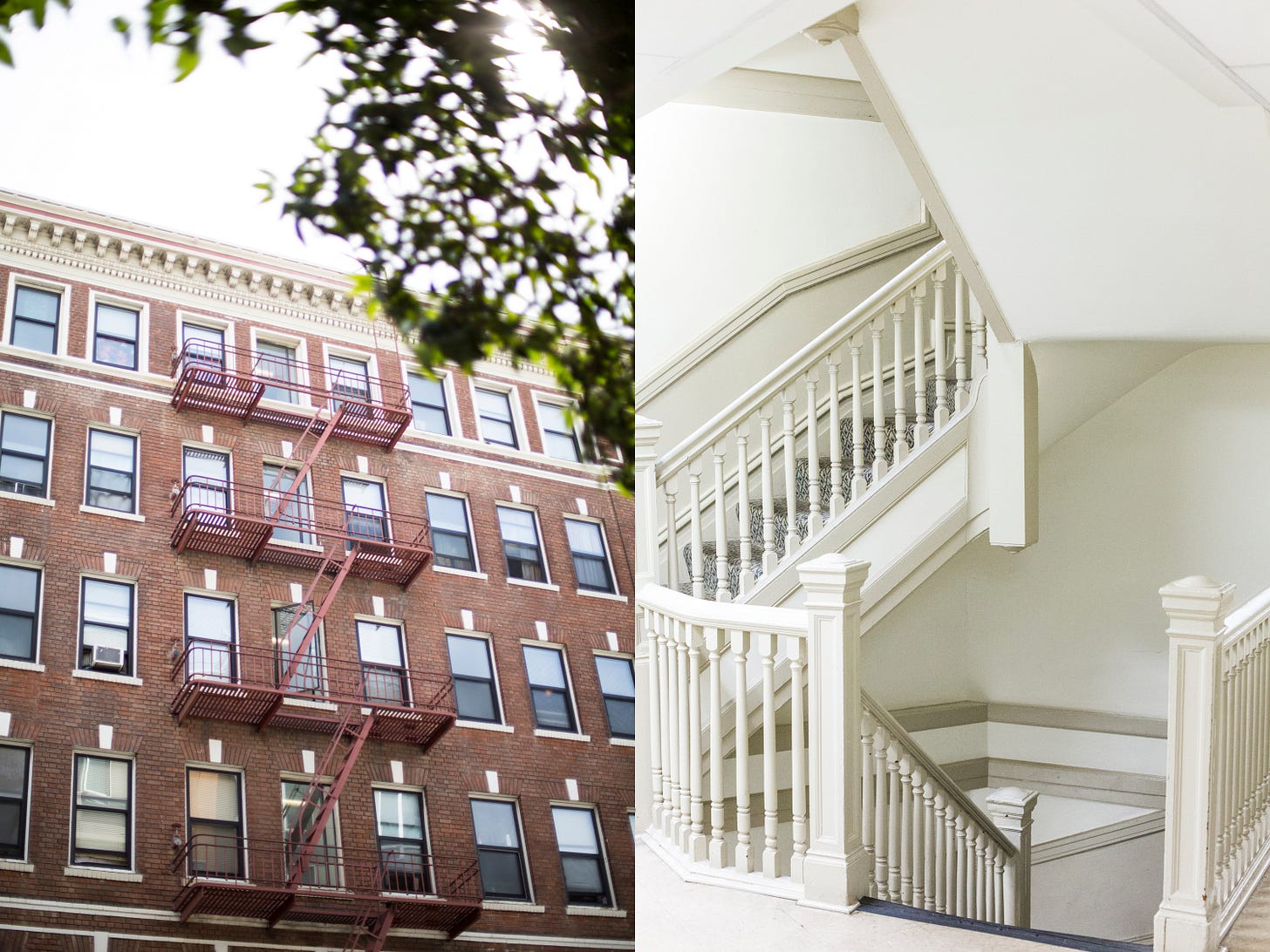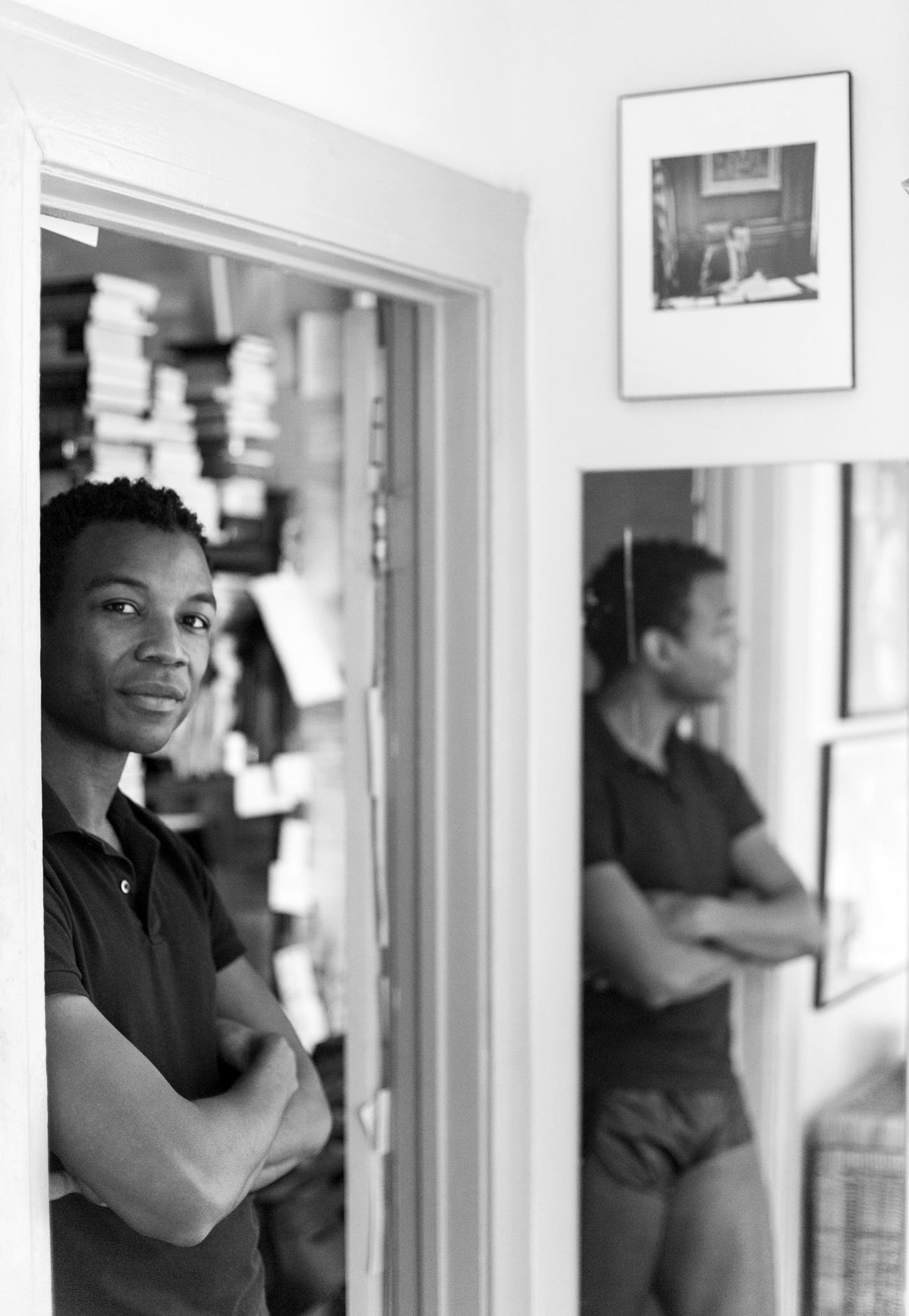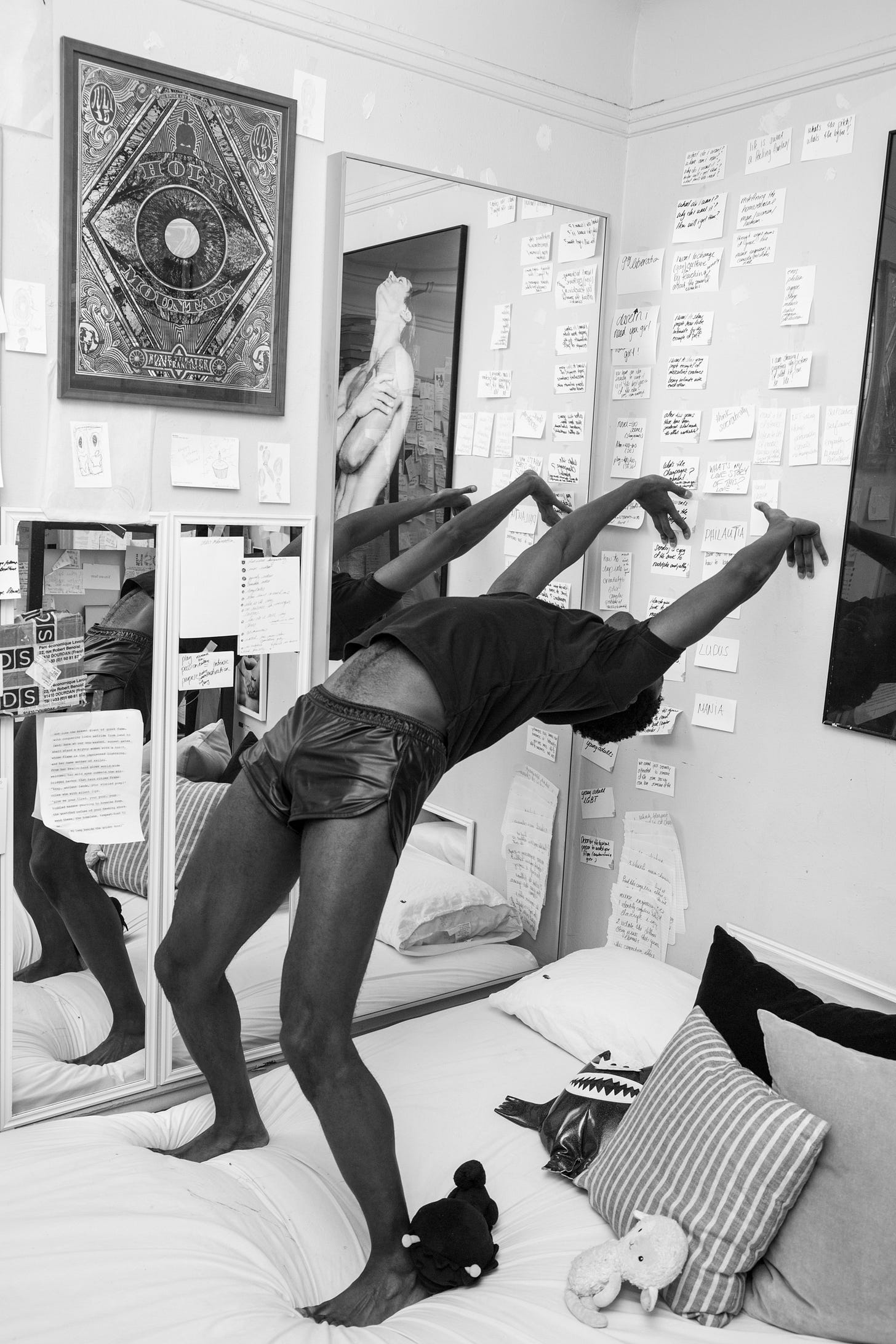At home in San Francisco, California with Joshua Jamil Dasein Teal
"I think style requires one to be vulnerable." -Joshua Teal
Good morning,
I recently photographed my friend Joshua Teal, a ballet dancer, at his downtown San Francisco apartment. Joshua moves precisely, with composure and elegance, then erupts in sudden, boundless laughter. When it comes to home, furnishings and traditional markers of domesticity bear little significance to Joshua. Instead, what matters to him is a space which offers privacy, freedom of expression, and positivity—a room of his own. This was one of the more vulnerable interviews I’ve done; concepts of home don’t always bring up easy feelings, and I’m grateful for Joshua’s brave honesty here.
Since the pandemic uprooted in-the-flesh dance classes, Joshua has been teaching private ballet lessons remotely. If anyone can edge a stiff body toward a flow-state, or impart the grace of ballet via a screen, it’s him. Joshua shares his home with a much older artist whose laminated, vivid collages one sees at first glance upon opening the front door. It sets the stage for their residence, a kind of hand-drawn, 3-D, expressive sketchbook. Joshua’s private sitting room is sparse; just plants, books and a place to sit comfortably, yet his bedroom walls are layered, absolutely covered with handwritten words—a paper fortress of intentions.
These mantras of sorts, made visible and physical on his walls, are the primary voice Joshua finds reassuring and motivating in a world that has regularly diminished him. As a child, Joshua moved constantly, and wasn’t allowed to put anything on his bedroom walls or to get attached to the places he resided. Today, home represents a place where he’s free to voice what he could not voice growing up in a restrictive—and constantly moving—home. I talked to him about writing on the walls, his love of oddly placed mirrors, his collection of nineties Calvin Klein posters, and the most frustrating feature of his flat.
Hello Joshua! What do you find most special about your home?
It was actually an old hotel at one moment in time. It is quite synchronistic—it describes my life—full of different people from different cultures. Opening and closing doors of opportunity.
You moved through many countries and homes throughout your youth due to your father being relocated very often due to his work in the military. As someone who’s home was never in one place for long, and who grew up in Germany, Austria, England and over six places within the United States, what’s your definition of home?
I think of home as a chameleon, always changing. Growing up, I thought I was free and limitless, yet part of my identity was not allowed to change colors. Now that I live in a place where I have the space to be an individual, I think home means freedom. Growing up, I was not allowed to have a dog, yet I spent hours in libraries learning about every breed of dog, studying their ailments.
I was not allowed to put things on my walls. I was not allowed to be myself. Moving erased the last place my family called home. I’ve held onto the idea of my body being my home because my body was the only place I could seek refuge as a child. My parents never allowed me to share my stories with them. Now I create my livelihood teaching ballet remotely, in my living room. It’s the place I feel safe to express myself—my sanctuary.
Tell me more about how you envision your body as a home.
I see my body as a planet: I need to take care of my own planet in order for another planet, or person, to join my orbit. They need to have their own orbit, also. I imagine myself being filled with all the things of the universe.
You share your home with an older artist who's taste is hyper-colorful, as if a San Francisco drag queen, a 1960's punk boy and a Keith Haring painting commingled and had an apartment-baby. How are you affected by sharing a small flat with your flatmate, and his bold aesthetic?
The first thing that comes to mind is his presence, which constantly reminds me to be myself. I have a hard time wearing the things I want to wear, saying the things I want to say. I sometimes have a fear of being persecuted for my actions. His presence reminds me to stay true, genuine and authentically myself. He reminds me to embrace my curiosity and continue to explore the many facets of my creativity. He has been a constant encouraging force for me.
You both seem to have a shared love of photographs of men, be they posed, erotic pin-ups, fashion photographs, or journalistic, documentary type imagery. You’ve got snapshot casual pictures next to images that are highly art-directed, like the stark, striking vintage Calvin Klein posters. Tell me a bit about this collection.
The collection is intentional; I want to embrace my sexuality. My flatmate and I are both interested in the same taste of photography, and I think my collection evolved as we began living with each other.
What did you consider when you set up your art and objects in this home where you don’t have very much space?
I consider the different lines in the room and how they extend the space in my flat. I have a petite place so I use mirrors and plants to create depth and expansiveness, making a “jungle-nest” within my home, to bring the outside into my flat.
Before the pandemic shut your dance classes down, you used to go to ballet every day. Did you create an alternative for yourself at home?
Yes, I give myself ballet classes. I have created my own workout routine that focuses on strengthening the smaller muscles needed as a dancer.
Do you do anything at home that you’d recommend to others? Things that may have brought you joy or ease?
I don't know if I recommend this to other people, but I’m constantly aware of how my body is fixed within space, and how I can grow taller. I use balls and other tools to release tension in my body, around my scapula and feet, before I leave my bedroom in the morning. I make sure I can do a full split before six am—it is possible!
Tell me about the writing on your walls. It's overwhelming and impressive! As a teenager I covered my walls—floor to ceiling—with pictures from fashion magazines, but I’ve only seen a handful of collaged, absolutely DIY-wallpapered rooms or even art studios, since. I'm curious how the writing on the walls works for you. Some notes seem like casual to-do lists and many appear more like personal affirmations, mantras of sorts.
The first thing that comes to my mind is the note, Dream, Joshua, dream. I think my whole life is based on a dream. A dream that I have of my life. I think as long as I continue to dream graciously that it will begin to become my reality. I think I’m also telling myself to keep moving forward.
Are there correlations between how you furnish your home and how you clothe your body?
Yes! I do both with a sense of bricolage and curiosity.
Do you think anything in your home has energetic or talisman-like properties?
My scents! I just put them on, and the whole world opens up to me.
Do you prefer gathering new or old objects for your home?
I do not gather things. I’ve watched Hoarders and realized why people hold onto things.
What did you realize? I’ve never watched it.
I think people, memories, and past feelings can become objects. I think someone who hoards wants to feel more comfortable, and in hoarding, those people, memories, and past feelings stay in one’s home, or multiply—to increase the comfort they lost. I think someone begins to hoard to gain more comfort from a deep loss in their life. It was painful to watch people have that type of experience.
I know you’re very sensitive to environs; is there anything you do to improve a room that affects you negatively?
I burn sage.
Is there anything about your home that you can’t stand?
There are these fucking chandeliers that continually remind me: How can I rethink that light fixture? I hate that even though I know I can do it, yet I keep thinking: I need a man to do that for me. The pain of not having a father there for me as a child keeps me from taking that light fixture down, picking out a new one, and installing it.
Do you think style can be taught, or that it’s imparted mysteriously, through osmosis? How did you nurture or develop your style?
I think style requires one to be vulnerable. I nurtured my creativity by being curious and non-judgmental.
Briefly describe your home.
Safe, secure, ataraxia, dasein: waiting patiently for my prince to come so I can sleep on his chest.
Describe your dream home in 5 words.
Like sleeping on a man's chest.
Delving Deeper…
Home is not always home sweet home. Home does not necessarily offer refuge and peace, even if one is lucky enough to have a place to call home. Asking Joshua about his past homes brought up some sadness. It also gave me a renewed appreciation for stable homes, no matter how humble or small; our bodies need shelter, safety, privacy, and a space for expression. Home is not just a place to fill, to design, to share with the world visually, but a place to hone the expansive powers of reflectivity—quietly, in contrast to all that which asks us to be outward-facing, productive, and always purchasing. Though I tend to gather objects and images in my home-space that remind me of the plethora of things I love, others may infuse their space not with things but with words, sounds, dance-moves, or just thinking. There is no manual, let your own interests lead you, it’s all interpretation so find a home-mantra that works for you.
Consider Home…
For a practical takeaway, consider employing mirrors to add spaciousness to a tiny room. Place them where the sun ricochets so its light reverberates into crannies that otherwise remain shadowed. Position sensitive plants that want just a bit of sunlight in that reflected light: they won’t bake there since reflected exposure is brief and soft, but they won’t go ignored in the shadows, either.
As above, try adding a pane of glass (cut to size) to a side or coffee table so it reflects a hanging plant or branches/sky from a nearby window. A black surface underneath the glass will be most mirror-like and precise. Reflective surfaces can bring nature, and unexpected bursts of natural light, indoors.
Whatever brings you unexpected bursts of energy and lightness, do.
Etymology Interlude:
Bricolage: bree-kuh-lah-zhiz (noun) A construction made from whatever is at hand.
From the 14th century French: bricoler: "to tinker”
The creative and resourceful use of available objects, regardless of their original purpose, to create something new.
Bricolage refers to an assortment of collected, provisional, shifting things. In the realm of cultural studies, bricolage is a phrase used to describe processes by which people acquire objects from across social spheres to create layered, updated identities. I like this orientation of bricolage, wherein objects that possess a certain meaning in the dominant culture are given a new, often subversive meaning through specific usage within one individual’s realm.
This month’s recommendations:
Miller’s memoir, free fruit, and post-punk piano…
Literary Offerings: I could not put down Know My Name, a fierce, funny, devastating, powerful memoir by Bay Area writer and activist Chanel Miller. In it, she speaks to her own experience of navigating the justice system after surviving a sexual assault. It’s astonishingly well written and her immense strength, intelligence, insight and unexpected humor in the face of such a brutal, all-too-common, subject moved me deeply.
Edible Offerings: LA Fruit Share is a free and bountiful annual scavenger-hunt across Los Angeles, coming up soon, on June 26th. It’s a dream that such a thing could happen regularly all over, in places ripe with neglected backyard bounty. It’s a timely and generous project co-created by Julia Sherman, an endlessly creative, industrious cook and artist. For those of you far from Los Angeles and restless and energetic enough to set up a chapter in your city, there is nothing to lose but spoiled fruit.
Sonic Offerings: My favorite thing to listen to while working, writing and cooking of late is The Durutti Column, particularly their debut album from 1980, The Return of the Durutti Column. Started by the British guitarist, multi-instrumentalist and composer Vini Reilly, it’s a hypnotic, cascading blend of sounds, mostly without vocals, inspired by folk, classical, punk, jazz and minimalist electronic music. It’s beautifully fluid, calming and energizing in equal parts. As Reilly states, "I had a lot of classical training when I was young, guitar and formal training, the scales I write with and the techniques I use are classical techniques and scales – a lot of minor melodic and minor harmonic scales, which generally aren't used in pop music.”
I waited a long time to find atmospheric, eclectic, highly listenable music like this; I hope you like it too.
Until next time,
Airyka















